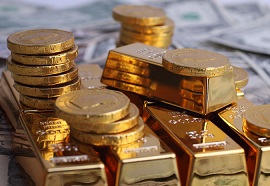Barron's: Gold is Cheap. Inflation is Coming. Do the Math!

Article by Andrew Bary in Baron's Publication
Gold has gotten a bad rap.
This year has been especially lackluster for gold. Its price has slumped 8%, to about $1,200 an ounce, and is off more than 35% from its high of $1,900 in 2011.
But this out-of-favor asset class now deserves a place in investment portfolios.
Compared with stocks and other financial assets, gold looks inexpensive. More important, inflation is starting to pick up in the U.S. and in much of the world as central banks shrink their enormous balance sheets. And gold has represented a good defense against inflation eroding the value of a stock or bond portfolio. Over time, it has held its value against the dollar. Gold was $20.67 an ounce 100 years ago and that bought a good men’s suit. At $1,200 an ounce, the same is true today.
“Gold is rare, and it’s hard to rapidly increase the supply of it,” says Keith Trauner, co-portfolio manager of the GoodHaven mutual fund. “People have historically viewed it as a hedge against government depreciation of local currency.”
There are an estimated six billion ounces of gold in the world, worth more than $7 trillion, about 30% of the value of the S&P 500. Annual new mined supply adds less than 2% to the global total.
“Virtually every government in the world is trying to promote inflation partly because there is so much sovereign debt,” Trauner says. When there is so much debt, he contends, governments have three choices: default, restructure, or inflate the currency. “Politicians, when given the chance, will choose the latter.”
Naysayers point to higher interest rates as a negative for gold because it increases the allure of holding cash. But gold had one of its best decades during the inflationary 1970s, when rates soared.
One catalyst that could change investor sentiment on gold is a decline in the U.S. dollar.
“Gold is the anti-dollar,” says Pierre Lassonde, the chairman and a co-founder of Franco-Nevada, a gold and mining royalty company with an $12 billion stock market value. “When the dollar is strong, there is no need for gold. But when the dollar is weak, people go back to gold.”
Historically, gold and the dollar have a negative correlation of 80% to 85%. The dollar has been supported by expectations that the Federal Reserve will keep tightening and lift its benchmark, the federal-funds rate, to 2.5%-3%, from the current range of 1.75% to 2% by the end of 2019.
Trey Reik, a metals strategist at Sprott USA, says the Fed may have to relent, in part because the upward pressure on rates is squeezing developing economies that have dollar-denominated bonds or other obligations. If the markets sense that the Fed is about to hold off, the dollar could drop and gold would probably rally. His view is that “gold offers enormous portfolio utility in today’s complex and treacherous investment environment.”
Currently, many U.S. investors own little or no gold, but there are a few prominent bulls on the metal. One is Jeffrey Gundlach, the outspoken and often prescient CEO of DoubleLine Capital, the big bond-oriented investment firm.
“In my June webcast, I recommended that gold bugs wait until $1,200 to buy because it had just broken below” a chart point at $1,290, Gundlach wrote in an email to Barron’s. He turned positive early this month when gold hit $1,196. Based on the technicals, “I am now bullish,” he concluded.
Gold has been a traditional hedge against financial and economic crises, playing that role during the 2008-09 meltdown. Gold rallied 17% from the collapse of Lehman Brothers on Sept. 15, 2008, until the stock market bottomed on March 9, 2009—a period during which the S&P 500 fell more than 40%.
Gold has had allure as a store of value and measure of wealth for thousands of years. And gold remains so in much of the world, including China and India. Before the 1930s, it was used as money in U.S.
How cheap is gold today?
One way to measure it against stocks is a comparison with the Dow Jones Industrial Average. It effectively takes 22 ounces of gold to buy one unit of the Dow, which finished on Friday at a record 26,743. The most recent low in that relationship occurred in 2011, when the Dow/gold ratio dropped to 7.8. Then, gold was near its all-time high of $1,900 an ounce.
In the futures markets, speculators, who are normally long gold, are now in the rare position of being net short. Many analysts view speculative positions as a contrary indicator and the current situation as bullish.
U.S. stocks are at record levels exactly at a time when global stress—trade tensions, populist nationalism, and the like—appears to be growing. This may be an opportune moment for investors to shift at least a portion of their portfolios to gold.
To read this article in its entirety on Baron's Website, click here